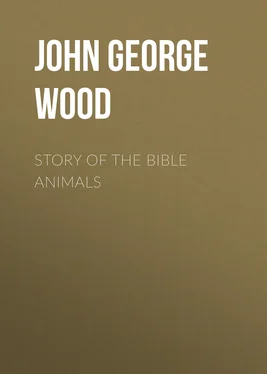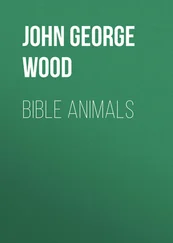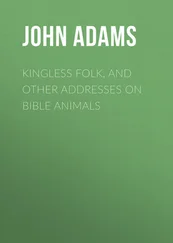John George Wood - Story of the Bible Animals
Здесь есть возможность читать онлайн «John George Wood - Story of the Bible Animals» — ознакомительный отрывок электронной книги совершенно бесплатно, а после прочтения отрывка купить полную версию. В некоторых случаях можно слушать аудио, скачать через торрент в формате fb2 и присутствует краткое содержание. Жанр: foreign_prose, foreign_religion, Философия, foreign_psychology, foreign_antique, на английском языке. Описание произведения, (предисловие) а так же отзывы посетителей доступны на портале библиотеки ЛибКат.
- Название:Story of the Bible Animals
- Автор:
- Жанр:
- Год:неизвестен
- ISBN:нет данных
- Рейтинг книги:4 / 5. Голосов: 1
-
Избранное:Добавить в избранное
- Отзывы:
-
Ваша оценка:
- 80
- 1
- 2
- 3
- 4
- 5
Story of the Bible Animals: краткое содержание, описание и аннотация
Предлагаем к чтению аннотацию, описание, краткое содержание или предисловие (зависит от того, что написал сам автор книги «Story of the Bible Animals»). Если вы не нашли необходимую информацию о книге — напишите в комментариях, мы постараемся отыскать её.
Story of the Bible Animals — читать онлайн ознакомительный отрывок
Ниже представлен текст книги, разбитый по страницам. Система сохранения места последней прочитанной страницы, позволяет с удобством читать онлайн бесплатно книгу «Story of the Bible Animals», без необходимости каждый раз заново искать на чём Вы остановились. Поставьте закладку, и сможете в любой момент перейти на страницу, на которой закончили чтение.
Интервал:
Закладка:
There is a very interesting account by Mr. Tristram of the haunt of these animals. While exploring the deserted quarries of Es Sumrah, between Beth-arabah and Bethel, he came upon a wonderful mass of hyænine relics. The quarries in which were lying the half-hewn blocks, scored with the marks of wedges, had evidently formed the resort of Hyænas for a long series of years. "Vast heaps of bones of camels, oxen, and sheep had been collected by these animals, in some places to the depth of two or three feet, and on one spot I counted the skulls of seven camels. There were no traces whatever of any human remains. We had here a beautiful recent illustration of the mode of foundation of the old bone caverns, so valuable to the geologist. These bones must all have been brought in by the Hyænas, as no camel or sheep could possibly have entered the caverns alive, nor could any floods have washed them in. Near the entrance where the water percolates, they were already forming a soft breccia."
The second allusion to the Hyæna is made in 1 Sam. xiii. 18, "Another company turned to the way of the border that looketh to the Valley of Zeboim towards the wilderness," i.e. to the Valley of Hyænas.
The colour of the Striped Hyæna varies according to its age. When young, as is the case with many creatures, birds as well as mammals, the stripes from which it derives its name are much more strongly marked than in the adult specimen. The general hue of the fur is a pale grey-brown, over which are drawn a number of dark stripes, extending along the ribs and across the limbs.
In the young animal these stripes are nearly twice as dark and twice as wide as in the adult, and they likewise appear on the face and on other parts of the body, whence they afterwards vanish. The fur is always rough; and along the spine, and especially over the neck and shoulders, it is developed into a kind of mane, which gives a very fierce aspect to the animal. The illustration shows a group of Hyænas coming to feed on the relics of a dead animal. The jackals and vultures have eaten as much of the flesh as they can manage, and the vultures are sitting, gorged, round the stripped bones. The Hyænas are now coming up to play their part as scavengers, and have already begun to break up the bones in their crushing-mills of jaws.
THE WEASEL
Difficulty of identifying the Weasel of Scripture—The Weasel of Palestine—Suggested identity with the Ichneumon.
The word Weasel occurs once in the Holy Scriptures, and therefore it is necessary that the animal should be mentioned. There is a great controversy respecting the identification of the animal, inasmuch as there is nothing in the context which gives the slightest indication of its appearance or habits.
The passage in question is that which prohibits the Weasel and the mouse as unclean animals (see Lev. xi. 29). Now the word which is here translated Weasel is Choled , or Chol'd ; and, I believe, never occurs again in the whole of the Old Testament. Mr. W. Houghton conjectures that the Hebrew word Choled is identical with the Arabic Chuld and the Syriac Chuldo , both words signifying a mole; and therefore infers that the unclean animal in question is not a Weasel, but a kind of mole.
The Weasel does exist in Palestine, and seems to be as plentiful there as in our own country. Indeed, the whole tribe of Weasels is well represented, and the polecat is seen there as well as the Weasel.
There is hardly any animal which, for its size, is so much dreaded by the creatures on which it preys as the common Weasel.
Although its small proportions render a single Weasel an insignificant opponent to man or dog, yet it can wage a sharp battle even with such powerful foes, and refuses to yield except at the last necessity.
The proportions of the Weasel are extremely small, a full-grown male not exceeding ten inches in length. The color of its fur is bright reddish-brown on the upper parts of the body, and the under-portions are pure white. The audacity and courage of this little animal are really remarkable. It seems to hold every being except itself in the most sovereign contempt, and, to all appearances, is as ready to match itself against a man as against a mouse.
It is a terrible foe to many of the smaller animals, such as rats and mice, and performs a really good service to the farmer in destroying many of these farmyard pests. The Weasel is specially dreaded by rats and mice, because there is no hole through which they can pass that will not also admit the passage of their enemy; and, as the Weasel is most persevering and determined in pursuit, it seldom happens that rats or mice escape when their little foe has set itself fairly on their track.
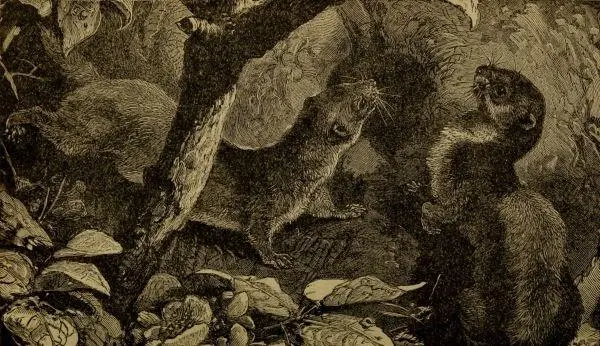
WEASELS.
Not only does the Weasel pursue its prey through the windings of the burrows, but it will even cross water in the chase. When it has at last reached its victim, it leaps upon the devoted creature and endeavours to fix its teeth in the back of the neck, where it retains its deadly hold in spite of every struggle on the part of the wounded animal. If the attack be rightly made and the animal a small one, the Weasel can drive its teeth into the brain and cause instantaneous death.
The Weasel is very fond of eggs, and young birds of all kinds. It is said that an egg that has been broken by a Weasel, can always be recognized, by the peculiar mode which the little creature employs for the purpose.
Instead of breaking the egg to pieces or biting a large hole in the shell, the Weasel contents itself with making quite a small aperture at one end, through which it abstracts the liquid contents.
A curious example of the courage of the Weasel, is related by a gentleman who while crossing a field at dusk, saw an owl pounce upon some object on the ground, and carry it in the air.
In a short time the bird showed signs of distress, trying to free itself from some annoying object by means of its talons, and flapping about in a very bewildered manner.
Soon afterwards the owl fell dead to the earth; and when the spectator of the aërial combat approached, a weasel ran away from the dead body of the bird, itself being apparently uninjured. On examination of the owl's body, it was found that the Weasel, which had been marked out for the owl's repast, had in its turn become the assailant, and had attacked the unprotected parts which lie beneath the wings. A considerable wound had been made in that spot, and the large blood-vessels torn through.
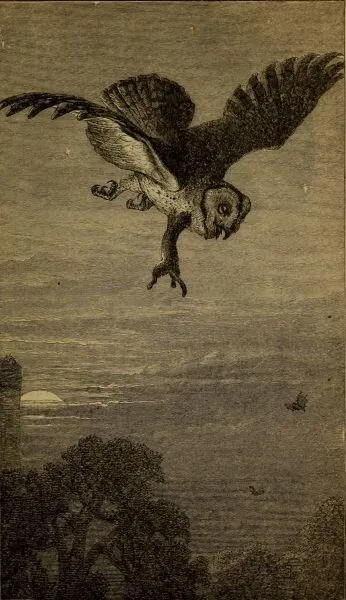
THE BITER BIT.
THE BADGER
Difficulty in identifying the Tachash of Scripture—References to "Badgers' skins"—The Dugong thought to be the Badger—The Bedouin sandals—Nature of the materials for the Tabernacle—Habits of the Badger—The species found in Palestine—Uses of the Badgers' skins—Looseness of zoological terms.
Until very lately, there was much difficulty in ascertaining whether the word Tachash has been rightly translated as Badger. It occurs in several parts of the Scriptures, and almost invariably is used in relation to a skin or fur of some sort. We will first examine the passages in which the Badger is mentioned, and then proceed to identify the animal.
Nearly all the references to the Badger occur in the book of Exodus, and form part of the directions for constructing the Tabernacle and its contents. The first notice of the word occurs in Exodus xxv. 5, where the people of Israel are ordered to bring their offerings for the sanctuary, among which offerings are gold, silver, and brass, blue, purple, and scarlet, fine linen, goats' hair, rams' skins dyed red, badgers' skins, and shittim wood—all these to be used in the construction of the Tabernacle. Then a little farther on, in chapter xxvi. 14, we find one of the special uses to which the badgers' skins were to be put, namely, to make the outer covering or roof of the tabernacle. Another use for the badgers' skins was to form an outer covering for the ark, table of shewbread, and other furniture of the Tabernacle, when the people were on the march.
Читать дальшеИнтервал:
Закладка:
Похожие книги на «Story of the Bible Animals»
Представляем Вашему вниманию похожие книги на «Story of the Bible Animals» списком для выбора. Мы отобрали схожую по названию и смыслу литературу в надежде предоставить читателям больше вариантов отыскать новые, интересные, ещё непрочитанные произведения.
Обсуждение, отзывы о книге «Story of the Bible Animals» и просто собственные мнения читателей. Оставьте ваши комментарии, напишите, что Вы думаете о произведении, его смысле или главных героях. Укажите что конкретно понравилось, а что нет, и почему Вы так считаете.
